
The ear on the right in the photo below was pulled from a sampling spot where yield was estimated at 222 bushels per acre. The ear on the left came from a spot where yield was estimated at 161 bushels per acre. That’s a 61-bushel difference. Believe it or not, the plants were in side-by-side rows and checked at the same spot!
How could yields vary so much from one row to another? Some reasons are obvious, and some aren’t. A couple may be unique to this field. Here are five possible explanations. Dave Nanda, a plant breeder and crops consultant for Seed Consultants Inc., sponsor of Crop Watch ’16, helped formulate these explanations.
1. Yield estimates are only a guess.

2 DIFFERENT YIELDS: These ears came from side-by-side rows. Yet yield estimates for the two rows were very different. The ear on the right has 18 kernel rows; the ear on the left has 16 rows.
There is nothing scientific about yield estimates for corn, even if you follow recommended formulas, Nanda says. The example above is based on a preseason estimate. Some people believe you can get within plus or minus 10% of actual yield. Others say it’s more like plus or minus 20%. If stars line up wrong instead of right, error in estimation could explain part of the difference between two rows.
2. Sampling error could play a big role.
Even if you standardize your method of estimating yields, error can creep in. Nanda prefers to walk to a spot at random within the 17 feet, 5 inches representing 1/1000 acre in 30-inch rows, and pull three ears in a row. Other people pull certain numbered ears from one end of the measured strip — say, the fifth, 10th and 17th ears. Either way, when there is only one count per row, odds of getting one ear out of three that isn’t representative of the entire row is high enough to cause error.
3. Some plants emerged later than others.
The yield difference may be real. When pulling ears, maybe you happened to get one from a stalk that emerged a couple of days later because emergence wasn’t uniform, Nanda suggests. Perhaps that ear wasn’t as long, or maybe there was more tip-back because it pollinated later.
4. Rows are planted to different hybrids.
If you plant two hybrids across the field to spread pollination risk, it’s possible you could land at a spot where the hybrid changed when taking estimates. Nanda believes this happened on one of the checks with a wide difference in yield estimates in the Crop Watch field. He notes that one row had ears that consistently had more rows of kernels per ear than the other row, and that the kernels were deeper on ears from one row compared to ears from the other. Both are indications of a shift in hybrids.
5. Two planting dates or widely varying emergence dates could be involved.
One of the Crop Watch checks varied widely because one row had more ears that were spotted in on a second planting about a month later due to spotty emergence. The same thing could happen if seed from one row wound up in moist soil and emerged quickly, but seed in the other row was shallower due to planter variation and lay in dry soil until it rained.
About the Author(s)
You May Also Like




